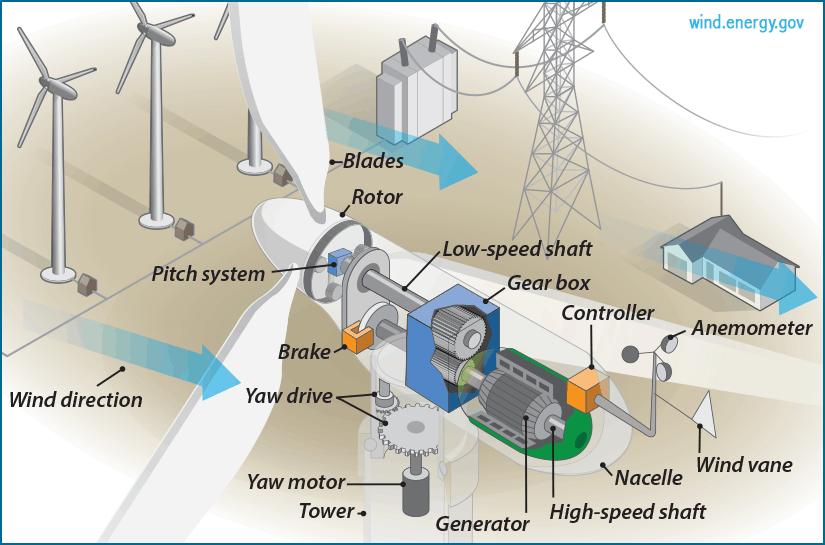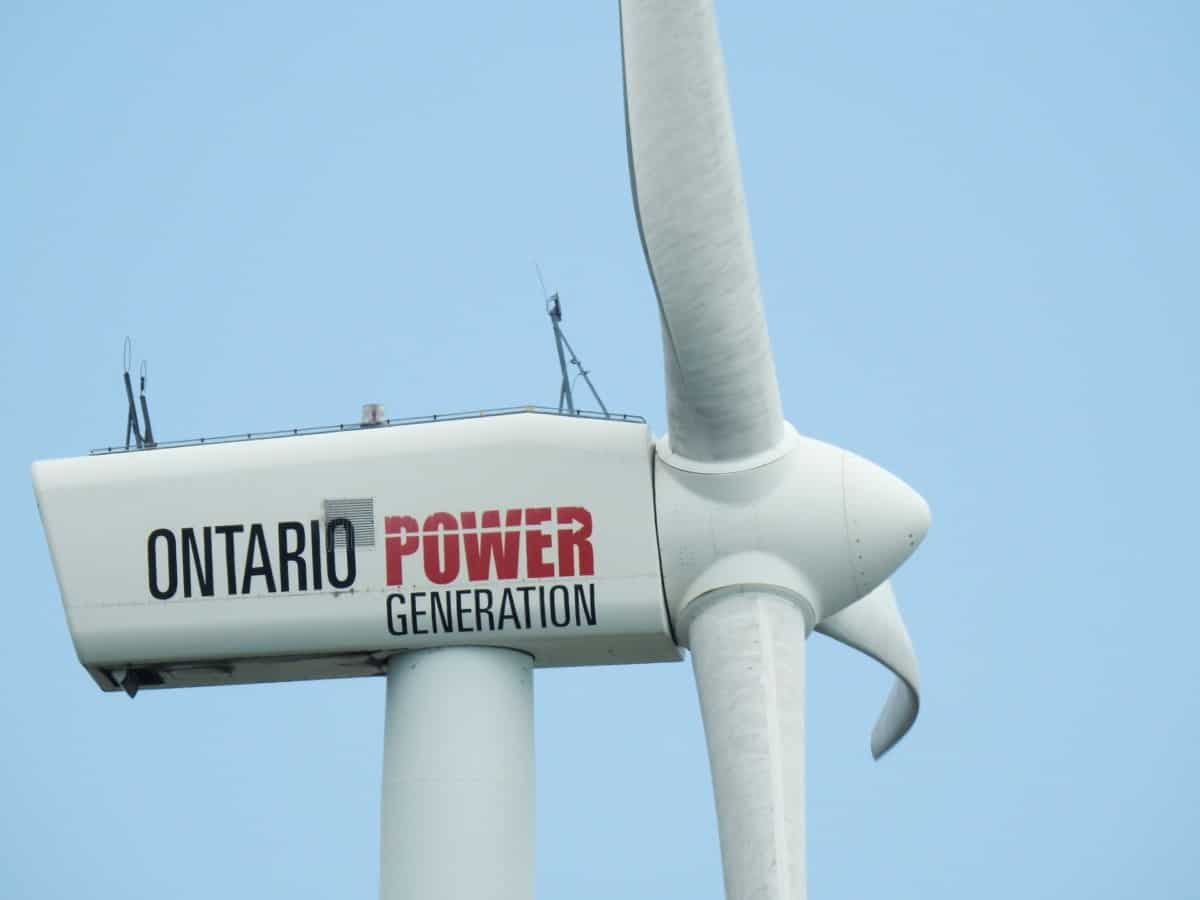How do Wind Turbines Work?
Are you wondering how do wind turbines work? Awesome, you are in the right place. The following words will offer you the insight you need to understand this process and understand what happens after blades rotate or you can simply watch the video below for all the information required.
Parts of wind turbines
The best way to understand how any given system works is by noting its parts and what they do. Here are the elements of the wind turbine system.
·Tower: It is the “leg” on which the entire wind turbine stands and raises the system to considerable heights to tap wind. They are mainly made of steel lattice, concrete, or steel.
·Nacelle: It is the housing of turbine components such as the generator, controller, shafts, gearbox, and shafts. Typically, it sits on top of the tower.
·Blades: They lift and turn when the wind blows over them and is the starting point of wind energy tapping.
·Low-speed shaft: It is an internal drive shaft that rotates along with the rotor and spins high-speed shaft through the gearbox.
·Gearbox: Connects the two shafts and increases the revolution speeds.
·High-speed shaft: It is the shaft responsible for transferring high-speed spins to the generator to drive it.
·Generator: It is part of the nacelle that converts kinetic energy into electricity through electromagnetic induction.
·Anemometer: Usually located at the back of the nacelle, it measures wind speed and transfers the data to the controller.
·Wind vane: Shows wind direction and transmits the information to yaw drive.
·Controller: It is a central point of the turbine responsible for starting and stopping the entire machine’s operation, depending on wind speed.
·Yaw drive: It is a system-like part of the nacelle that properly orients the turbine whenever the direction of the wind changes.
·Brake: Like any other brake, this is the part that stops the rotor during significantly stronger winds or any other time when due.

Step-by-step production of wind energy using turbines
There is tons of energy locked in the wind, and the turbines have made it possible to convert the energy into useful power. Wind energy forms one of the common and most rampant renewable energy across the globe.
It is quite clear that wind turns the propeller-like blades around the rotor; this spins a dedicated generator which produces the electricity. But I am pretty sure you know this, and you want to dive deeper and understand what happens where before current flows.
Unlike a fan that uses electricity to create wind, turbines use a straightforward principle to change wind to useful power. Now let’s discover how do the wind turbines work.
What happens after blades rotate?
This is one of the most prominent questions of all ages. Let’s look at how wind turbines work to tap wind to mechanic energy or electricity. Typically, wind energy starts with the sun heating a given region and, as usual, the air above that region.
Step1: The kinetic energy in the wind applies pressure on long, slender, propeller-like blades, making them spin. The wind does not necessarily need to be strong; wind turbines will start to turn at a wind speed of around 5 meters per second. It is noteworthy that most wind turbines have 2-3 blades.
Step 2: The spinning blades turns the rotor. Rotor composes of the blades and the hub. As the rotor spins, it causes the internal drive shaft to rotate approximately 30 to 60 revolutions per minute. The central driveshaft is also known as a low-speed shaft because it turns slower than the rotor blade edges.
Note: Mostly, the rotor blades are able to swivel on the hub to help tap wind at best and appropriate angle. This is common in the modest wind turbines. The ability to swivel is called a pitch control mechanism.
Step 3: The gearbox connecting the central driveshaft and the high-speed shaft jump-starts the rotations. Typically, it changes the speed from 30-60 revolutions per minute to around 1,000 to 1,800 rotations per minute. This is the ultimate speed required by assembling the magnets of the generator for electricity production.
Note: Gearbox is massive and, at times, costly; therefore, engineers are working effortlessly to get a direct drive that can work at lower speeds and without necessarily needing a gearbox.
Step 4: The higher revolution from the high-speed shaft drives the generator. The generator, located immediately after the gearbox, receives the kinetic energy and turn it into electrical power.
Basically, a 2-megawatt turbine generator will produce approximately 700 volts with two million watts while operating at its maximum capacity.
Note: The anemometers and the wind vanes, usually found on the back of the nacelle, measure the speed and direction wind then transfers the data to the controller and yaw drive, respectively.
The controller is responsible for starting and stopping the wind turbine so that it operates at the desired wind speed. Generally, wind turbines operate at speeds between 8 to 55 miles per hour, beyond which it can’t start or continue running.
If the wind speed is too high, the brakes are automatically applied to stop rotors from turning and prevent possible damage to the entire system. Brakes are also handy during regular maintenance. The yaw motor rotates top as the whole of the turbine to orient it with wind direction.
Step 5: The produced current will flow through the cables; typically, running internally through the turbine tower.
Step 6: The electricity produced is tapped in a step-up transformer where it converts to a substantial amount that can be transferred to the power grid with greater efficiency. If the turbines are serving a considerable network, the wind energy is to higher amounts depending on the grid requirements.
The surrounding areas can enjoy the clean and environment-friendly energy, courtesy of wind turbines.
How much electricity can turbines produce?
Mostly, turbines have 2-3 MW capacity and produce more than 6 million kWh (kilowatt-hours of wind energy annually.
This means wind turbines can address approximately 1,500 household’s power requirements. Generally, the power produced depends on wind speed; however, with extreme speed, the entire system shuts. But what happens when there is no wind? Find the answer by reading my article, How do Wind Turbines Work Without Wind
Reports from the research show that doubling of wind speed results in 8x electricity production. When the wind farms are planned well, wind turbines can produce highly reliable electricity, up to 70%.
Pros of wind power
·Renewable and sustainable: Wind power is renewable and sustainable because it mainly depends on nature. The spinning of turbines is affected by the sun heating the atmosphere and earth rotation. This means you will get electricity as long as the sun shines.
·Clean and environment-friendly: Production of wind energy does not pollute the environment since no atmospheric emissions. Additionally, it plays an indispensable role in keeping the environment green by reducing fossil fuels’ use, which emits pollutants.
·Cost-effective: The fact that wind is free to make the costs too low. Additionally, wind energy does not require complicated high technology, which suppresses the prices.
·Domestic source of power: Wind turbines use a fraction of the land when installing, which causes minimal disturbance on other land activities. A smaller turbine will provide enough wind power that meets the family needs.
·Job creation and source of income: The entire process from manufacturing, the installation, to regular maintenance creates job opportunities. The wind power sector has made jobs available for more than 600,000 people. Additionally, if wind turbines are installed in your land by substations, it can be a way to generate income.
·Reduces energy imports: Wind power can sustain power needs, therefore, being a reliable source of electricity. These cuts down power import and the possible costs are channeled to other sectors.
·Various usages: Turbines can be used and work effectively anywhere across the globe, provided there is reliable wind.
Drawbacks of wind turbines
·High up-front costs: Typically, the cost of purchasing and installing wind turbines is high. However, this does not outdo the overall saving during the entire service of the structure.
·Suffers wind fluctuations: Not all places have reliable wind that can help tap the hidden energy and convert it to electricity. The fact that wind will never blow throughout makes it a great challenge to use wind energy as the only electricity source. Manufacturers may also suffer when testing for regions with the stable wind to keep running the turbines.
·Noise and aesthetic pollution: Despite the minimal impact on the environment, the blades of turbines can be too noisy, which creates a non-conducive environment. A single turbine can disturb silence within a radius of hundreds of meters. Turbines, especially the large ones, will distract you from viewing the wonders of nature.
·A threat to wildlife: Spinning wind turbines pose a significant threat to flying animals. They have killed a considerable number of birds and bats. However, the problem has been resolved to greater heights by technological development and proper siting of wind farms.
·The turbine may not be the best way to utilize the land optimally.
More information can be found here.
Conclusion
Wind power sets one of the promising sources of electricity in the future. However, wind turbines have not been perfect; they can be highly reliable if wind farms are well established. Keep the doubts away and harvest the hidden energy in the wind.
If you have found this article, how do wind turbines work? Useful please share it, Thank you.
Recent Posts
Understanding Energy and Electricity: The Power For Progress
Energy and Electricity Energy and electricity are integral components of modern life, powering everything from homes and businesses to transportation and communication. Without them, the...
The Future of Wind Energy The future of wind energy is set to play a critical role in addressing global energy needs while combating climate change. As renewable energy sources like wind and...


